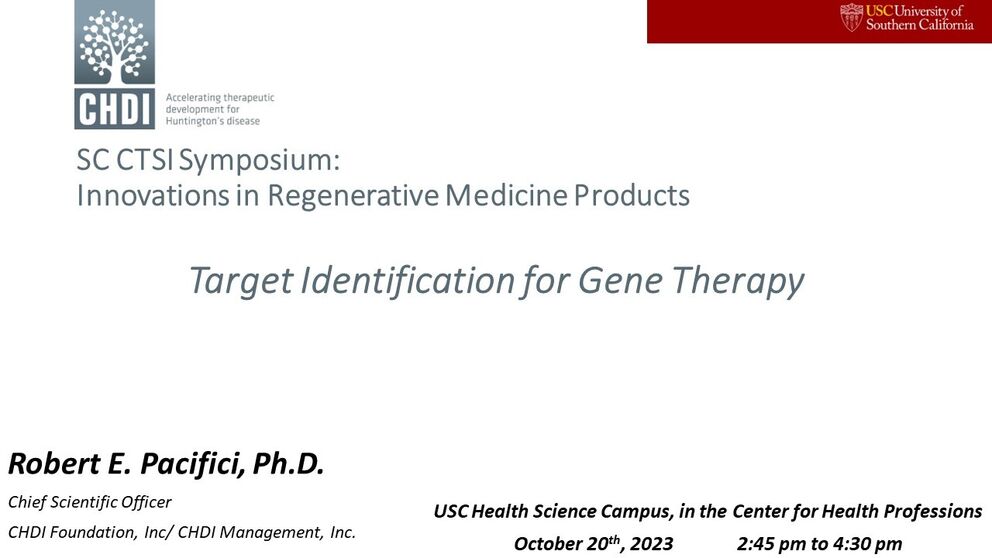Syllabus/Topics
- Presentation outline:
- Gene therapy
- Schematics
- Target Product Profile (TPP)
- Huntington's Disease
- Illustrative Programs
- Takeaways
- Gene therapy:
- Gene therapy definition
- Can work by several mechanisms
- Broad applicability
- Why do we need another “therapeutic modality”? (comparison of drugs and gene therapy)
- Small molecules:
- Pros: Cheap and orally bioavailable
- Cons: Limited target traceability and chronic administration
- Gene therapy:
- Pros: All genetic targets are accessible with “one and done” mechanism
- Cons: Limited distribution, costly, relatively new field - limited safety data
- It works! There are FDA-approved therapies.
- Small molecules:
- Schematic: Elements of gene therapy “drug”
- Payload (genetic material to be delivered – DNA-based/RNA-based)
- Flanking sequences (Promoter, Viral LTRs, caps, and non-natural nucleotides)
- Vector: Gene Carrier
- Viral (sero) type: Virus which doesn’t introduce a disease
- Target Product Profile: Specification for Safety and Efficacy
- Target validation: The desired target
- Desired pharmacology: The desired gene product
- Biodistribution: Which organ(s)/tissue(s), which cell type(s)
- Root of administration: Ex-vivo(mostly), peripheral administration, central administration
- Safety: Risk-benefit of “irreversible” treatment - when to treat prevention/too early versus reversal/too late
- Huntington’s Disease (background,
- Discovered by George Huntington in 1872
- Describes movement disorder and chorea
- Hereditary disease
- Autosomal Dominant
- Males and females have the same chance, no “recessive carries”, children have 50:50 chances of having it.
- Monogenic disease with 100% penetrance
- Relatively rare disease with a ratio of 1:10,000
- The full sequence of the gene was discovered in 1993 for Huntington's disease
- Causes
- Enables Genetic Testing (diagnostics):
- Predict who is going to get the gene and when
- Enables family planning, pre-implantation genetic diagnostics
- Can make animal models of HD
- Gene Therapy (modulation of a gene)
- During Transcription:
- AAV-ZFP
- CRISPR-Cas 9
- Small Molecule Transcription blocker
- Discovered by George Huntington in 1872
- During Translation:
- AAV-miRNA
- ASO
- siRNAs
- Small molecule translation blocker
- Degradation enhancers
- Development of pharmacodynamic biomarkers
- Many diseases like Huntington's disease are developing in human beings
- Therefore, a biomarker was developed to identify IF there is any kind of defect in the human gene or not.
- CHDI in collaboration with others used cerebrospinal fluid from the Huntington patients to check their Huntington levels in their body.
- Discussion on Huntington's Disease gene therapy profile
- Illustrative Programs:
- Example 1: Takeda’s TAK-686
- Example 2: uniQure’s AMT-130
- Example 3: Voyager
- Takeaways
- Despite initial difficulties, gene therapy remains an important modality
- Hundreds of other diseases are a candidate for gene therapy
- Significant advances in viral capsids promise improved safety profiles, facile routes of delivery, precise special and temporal targeting
- Large (and evolving) array of payloads
- Challenges remain
- Questions
- Symposium Wrap-up
- Symposium resource: “Innovations in Regenerative Medicine Products and Types of Regenerative Medicine Therapies”
- Can be found in the electronic binder
- Complete program evaluation survey to receive certificate of completion
- Wrap-up discussion
- Thank you!
Acknowledgment
Accompanying text created by Roxy Terteryan, RKS Project Administrator, SC CTSI (atertery@usc.edu)


